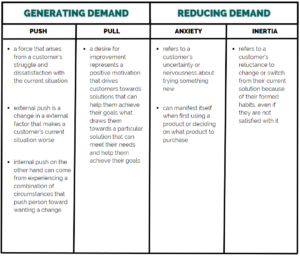The concept of “Jobs to be Done” has been gaining popularity in the world of product development and marketing, as it helps businesses understand the underlying motives and needs behind customer behavior.
Instead of focusing on what customers are buying, this approach looks at why they are using the product and what job they are trying to accomplish. By focusing on these jobs, companies can design better products and services that truly meet the needs of their customers. It can help businesses to define markets, create growth models and understand what consumers value most in a product.
What is a Job to be done?
The theory is based on the principle that humans constantly strive to improve their lives and that the desire for self-improvement is a core human desire. In this context, a job represents the aspiration to become a better and improved version of oneself. Since humans are limited in their ability to change their life-situation on their own, progress can only be made when new ideas and new products are attached and integrated into their lives.
In other words, a job in Jobs to Be Done is a process of making progress that customers want to achieve and it is precisely these jobs that are the main reason a customer would hire a product. For example, if I wanted to grow my business network, I could create a LinkedIn account that would get the job done for me.
Market segmentation
Usually, when companies are designing a product, they often segment their targeted market into personas. If we look at a company that is designing a mobile app for tracking finances, one of these personas could be defined like this:
“Natalie - a single, employed woman in her late twenties with a technical background who lives in the city and enjoys spicy food“.
However, this type of segmentation can lead to inaccurate assumptions and false conclusions. In the previous example, Natalie’s age, marital status, place of living, and certainly her liking of spicy food have nothing to do with her use of the finance management app. She will not buy a subscription for the app because she is single or because she has an active lifestyle, but rather because she wants to feel in control of her finances.
And who’s to say that
“Mark – a married man in his 50s, father of two, lives in the suburbs, works at a car dealership business, and likes watching football” doesn’t have the same need to feel in control of his finances? Segmented like this, Mark and Natalie have nothing in common and we would never look at them as the same potential customers, but in the context of JTBD, they would be segmented together. They both have the same job to be done regardless of any demographic data associated with either of them – keeping up with their finances..
4 Forces of progress
Customers usually don’t want your product and they don’t have the desire to interact with your company – they simply want what helps in getting their job done. They may or may not hire your solution, but in both cases, the job still exists.
Secondly, it’s people that have jobs to be done. Not products. For example, a car doesn’t have a job of getting you from one place to another. It’s a solution, and the features of the car are simply means to an end in delivering progress to the customer.
And lastly, it’s not enough to simply create a flawless product. There’s always something new that will come along and disrupt the market. So here’s a friendly tip: focus on the job as the center of innovation. That’s vital.
To understand what shapes customer demand, JTBD theory focuses on customer motivation and four forces of progress: push, pull, inertia, and anxiety. A combination of these forces is the reason why people do or do not hire a product.

Tackle the competition
The JTBD theory defines competition as any alternative solution customers consider when trying to get a job done. Competition is designed in the customer’s mind and all the systems they consider for satisfying their needs are your product competition. Joseph Schumpeter’s creative destruction principle explains that customers can only use one system of solutions for one job at a time.
If a customer hires on product for getting their job done, they will stop using the previous system used for that same job.
This idea can be used when positioning the product on the market. Recognizing what and why customers consider your competition reveals the value your product can deliver.
Benefits to take on JTBD
To sum it up, using the JTBD principles can help your organization to focus on the customer and what their goal.
Get ready to take some notes!
- Making the job the unit of analysis can help you better predict the changes in the market and make your ideas more future-proof.
- It can also help you reveal opportunities when positioning yourself against your competition.
- And finally, it can even help you run your organization by shifting the focus of all of the departments to one thing – the job to be done. This shift in focus can help your marketing do a better job of addressing the customers’ desire for progress. It can also help the sales department to understand what customer value hides in your product. And last but not least – it can improve communication between departments.
Want to try it out yourself or learn more? Reach out to our business STUDIO 23 team who incorporates JTBD in our daily work of building digital products.
Related News



